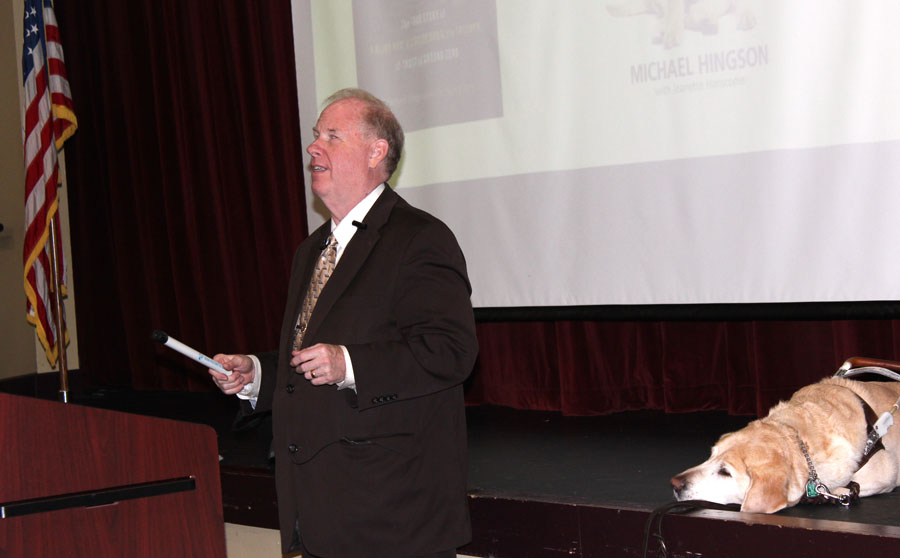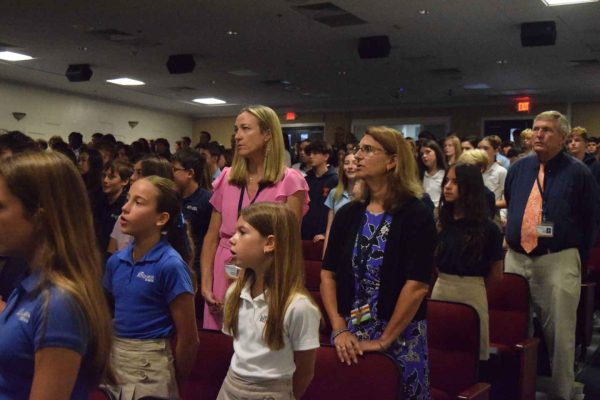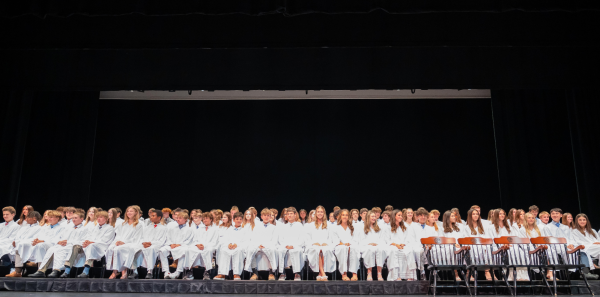9/11 Survivor Visits TBS
Michael Hingson, with his dog, Africa, speaks to the students about how he gets around, admitting that he relies more on his guide dog than his cane.
On November 11 and 12, Michael Hingson, author of Thunder Dog, a true story about a blind man who escaped the Twin Towers on 9/11 with his guide dog Roselle, came to The Benjamin School to speak to students.The seventh and eighth-grade read Thunderdog as part of their summer reading, so this visit by the author was particularly relevant for them. Mr. Hingson also has adapted his subject matter for young readers with the YA version of Thunderdog, titled Running with Roselle.
Mr. Hingson began his visit with the Lower School on the morning of November 11. He and his current guide dog, Africa, met with the older children (grades four and five) first and then moved on to grades one through three, and then the WOW and pre-k four students. In preparation for Hingson’s visit with the Lower School, the fourth-grade teachers read Running with Roselle in their classes, and Ms. Benvenuto read Running with Roselle to the fifth graders in Skills class. The Neersyde asked Ms. Benevenuto about her experience reading Roselle with the 5th grade: “From the bit of reading we did in class and the presentation given by Mr.Hingson, I think the students and teachers (including me) learned a great deal,” commented Ms. Benvenuto. “We learned that we should never underestimate what anyone can do, and we should look at people not based on their differences, but as who they are as people. We also learned of the amazing bond of trust between people and their guide dogs as well as the great deal of self-control and discipline a guide dog maintains when he or she is working.”
In preparation for Mr. Hingson’s visit, Lower School art teacher Ms. Sammis had her first-grade students write their initials in braille on clay tablets. The fourthth grade, also under Ms. Sammis’ direction, made pictures of dogs on tile. These were not in braille, but were engraved and thus could be experienced by feeling them.
“I wanted the students to understand that braille is actually a language,” explained Ms. Sammis, “and there were many students who were familiar with braille. I asked them how they knew about braille, and they told me that they see the braille on the bathroom signs [at Benjamin] before you go in the restroom.” Ms. Sammis was able to show the students’ work to Mr. Hingson during the Lower School presentations, and he was very appreciative and impressed with the work of the students.
On the evening of November 11, Mr. Hingson presided at the Diversity Book Club from 5:00-8:00 pm. Big Apple Pizza served a great Italian meal that book club members enjoyed at the seventh and eighth-grade lunch areas. At 6:00 p.m., all members headed to the BPAC. Many parents, students, and faculty attended the Diversity Book Club that night.
Mr. Hingson began his speech by explaining that he had been blind since birth, and the reason he was blind was because he was born 2 months prematurely, so he was exposed to pure oxygen to build up his lung capacity. Hingson developed a condition called retinopathy due to prematurity which means that years ago when an infant was born early and their lungs hadn’t developed yet, doctors exposed them to pure oxygen. This helped the lungs develop but caused blindness. When he was brought to the doctor as an infant, it was suggested that because he was permanently blind that he be sent away to a facility for the disabled, but his parents kept him with them. He was pretty much like any other ordinary boy. Hingson told the story of how when he used to ride his bicycle in his neighborhood his parents would get calls from his neighbors complaining to Mr. Hingson’s parents that their blind child was riding his bike around the neighborhood. Hingson’s parents didn’t listen to their neighbors’ remarks about him riding his bike. Hingson also talked about how he got his first guide dog Squire when he was in high school, and he talked about all the jobs he had. He explained how he got a job in New York working at the World Trade Center. He also talked about how the morning of September 11 began and how that day he had a meeting. He said that when the planes crashed, the tower started tilting but didn’t fall. He then related the story of his descent down 1,463 stairs to escape the towers. Not long after he exited the building, he heard it come down, and he talked about how he and Roselle were running in the big dust cloud. After he spoke to the book club members, Hingson unharnessed Africa, and the students all ran up to pet her.
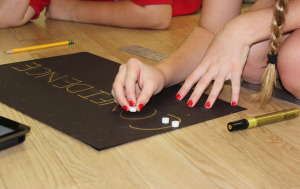
Seventh grader Josie Austin creates a braille form of her advisory’s word – confidence – which they went on to present to Mr. Hingson.
The next day Hingson returned to talk to the middle school students about being blind, the skills of perseverance, and moving from thinking of disabled people as different to including them and recognizing that we all have differences. Hingson was the centerpiece of a half-day curriculum for middle schoolers who were dismissed at noon that day. After he spoke, students returned to their advisories at about 9:30 am to conduct a project devised by Middle School Art Chair Ms. Nancy McAllister. In their advisory groups, students were given black construction paper, rulers, markers, braille alphabets, and 3-D dots so that they could make a word in braille that describes Mr. Hingson. He went with Africa to different classrooms to help the various advisories write their words properly in braille.
When advisories reconvened with Mr. Hingson in the BPAC, groups went one-by-one to the front of the BPAC and presented their words describing Michael Hingson to everyone there. The poster with the words was then given to Mr.Hingson, and he ran his finger over the braille to make sure it was correct. Posters were then arranged on a big frame that was standing by the side of the stage in front of the BPAC. Sixth graders John Sweeney and Garrison Gelman helped put the words on the frame. After all of the presentations, Ms. Mack’s history students, who had made a monument to Roselle as part of their history unit on heroes, presented the monument to Mr. Hingson. The statue depicts the burning twin Towers on a staircase down which Roselle is walking. Mr. Hingson felt the statute, particularly the two protrusions that depicted the Twin Towers, so he could get an idea of how the eighth graders made it and what it looks like.
Dean of Students Mr. Cavallo and his advisory group then came to the front of the stage to present Mr. Hingson with a navy blue TBS shirt, and they even got
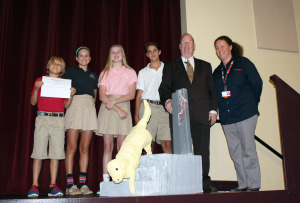
Milkbone dog treats for Africa. Hingson told the assembled Middle School that he was going to use a photograph of the monument as the new logo for his non-profit organization. Mr. Hingson closed his remarks to the Middle School by quoting a speech by National Federation of the Blind founder Dr. Jacobus tenBroek. The speech was made at the 1965 convention of the National Federation of the Blind in San Francisco. Dr. tenBroek discussed a famous story of John Bradford from the 16th century. Allegedly, Bradford encountered a beggar on a stormy night and said, “There but for the grace of God go I.” tenBroek felt that Bradford’s comments showed arrogance on Bradford’s part toward the beggar as if God had decided that the beggar was a lowlier creature than he and that God had given grace to Bradford and no grace or blessing to the beggar. tenBroek likened Bradford’s perception of the beggar as a poor unblessed being who one must hold at arm’s length to the treatment of those with disabilities in the world now. tenBroek ended his speech by saying that instead of saying “There but for the grace of God go I,” Bradford should have said, “There within the grace of God do go I,” suggesting that Bradford should have reached out and embraced the beggar as a fellow human. Mr. Hingson certainly echoed that sentiment in his presentations to the Benjamin school, making us all think less about diversity and more about inclusivity.
